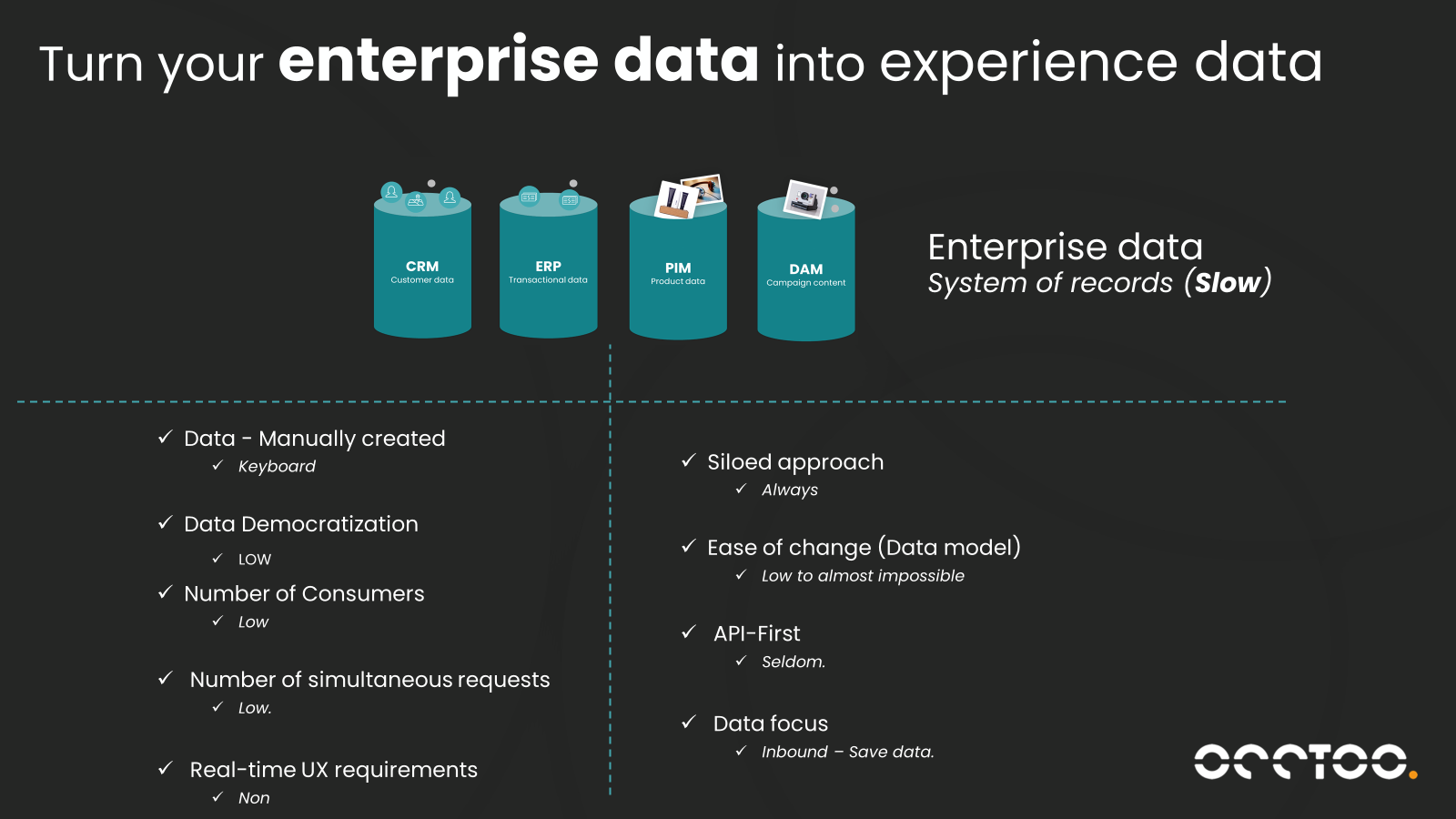There is no denying that data has become the lifeblood of business operations, flowing through all aspects of digital touchpoints. Despite the massive volume of information collected by businesses today, a critical hurdle remains i.e. transforming this wealth of data into meaningful, personalized interactions creating long-lasting customer relationships. So why, in a world where data is collected at every turn, does this challenge still exist?
The real reason being that most of this ‘enterprise’ data never gets converted into ‘experience’ data.
What do I really mean by that? Well, to understand this, let’s first figure out what exactly is Enterprise Data.
Enterprise data, is data that is traditionally stored in systems of records such as PIM, CRM, ERP, DAM and due to its siloed nature, it often operates at a slower pace. The manual creation of data and the low democratization of information contribute to a limited number of consumers and simultaneous requests that can be handled. Due to the complexity associated with extracting data from different siloed systems, real-time user experience (UX) requirements often remain unmet, leading to a fragmented approach to data, characterized by silos that hinder seamless collaboration.
Now, let’s understand what’s Experience Data!
Experience Data is when you can easily combine and activate content, customer, and context data from any source, without time consuming integrations or spending hefty budgets. Experience data exhibits a remarkable contrast in terms of speed and accessibility. It can be swiftly consumed to fuel a multitude of customer experiences. The ease of onboarding large volumes of data, coupled with high democratization, allows a broad spectrum of consumers to harness its power from IT teams to digital teams. The scalability of experience data, both geographically and automatically, ensures that it can meet the demands of a high number of simultaneous requests.
Why should you convert Enterprise data into Experience data?

Ease of data modeling: One of the main distinction points lie in the approach to data modeling. Enterprise data often struggles with a rigid structure, making it challenging to adapt to changing business needs. The siloed approach further makes it harder in modifying data models. In contrast, experience data is characterized by its flexibility—the ability to easily change and adapt to data models as per business needs, ensuring adaptability to evolving requirements. This is particularly crucial in a business landscape where agility is synonymous with success.
API-first : Moreover, experience data embraces an API-first philosophy, making it super adaptable to the modern tech ecosystem. Auto-documented APIs simplify all interactions with data, ensuring that developers and stakeholders have clear and accessible information. This stands in contrast to the traditional enterprise data, which is rarely API-first, making integration cumbersome and time-consuming.
Data democratization: Data democratization is a key aspect that sets experience data apart. The high level of accessibility and usability democratizes the data, allowing a broader range of stakeholders to leverage it for digital initiatives. In contrast, the restricted access and low usability of enterprise data limit its impact, confining its potential to a select few within the organization.
Speed and agility: The ability of experience data to handle real-time UX requirements is a game-changer. In today's fast-paced digital world, customers expect instantaneous responses and personalized experiences. Experience data, with its speed and agility, aligns perfectly with these expectations, ensuring that businesses can meet and exceed customer demands.
Escape the integration nightmare: Unifying experience data eliminates the need to move data between incompatible databases and data models. It prevents the repeated building of integrations, saving time and effort. This time can be better utilized on initiatives that add value to your customers.
Enhanced collaboration, increased creativity: The removal of a siloed approach in experience data fosters collaboration across departments. The high reusability of data ensures that insights generated in one part of the organization can be leveraged elsewhere, promoting a cohesive and interconnected data ecosystem.
Enable innovation and creativity: Access to unified data empowers your CX teams to be data autonomous. They can spend more time being creative and innovative, rather than struggling to access the data they need. An empowered team can drive innovation, making your customer experiences truly exceptional.
CONCLUSION:
.png?width=1600&height=900&name=image%20(1).png)
Thus, the conversion of enterprise data into experience data marks a transformative shift, offering digital agility, speed, and accessibility. As businesses face new digital challenges with ultra-digital-savvy consumers of today, turning the state of your data into experience data is not merely a strategic decision but rather a business need.
So, what’s your choice, jump ahead or lag behind in the digital game?!
You may also want to read: